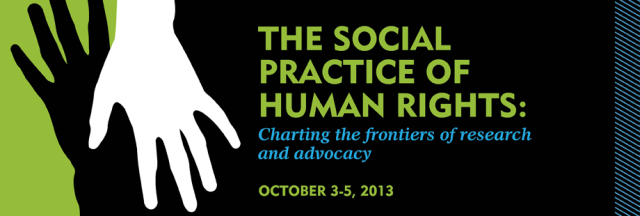The Unfolding Story of Human Rights Reporting: Tensions, Strategies and Next Steps
Location
River Campus - Room M2005
Start Date
10-4-2013 3:15 PM
Abstract
What happens when the objective journalist and the crusading journalist, inhabiting the same body, want to report on human rights? This talk examines the tensions between two ideals of western journalism: the dispassionate, detached observer searching for “the Truth” that is waiting to be reported (Lippmann, 1922) and the muckraker uncovering injustices in the hopes of making a better world. In other words, what is the role of journalism within human rights work and human rights education within journalism? My talk examines this question in three ways: reflecting on my own experiences in teaching human rights to journalists, mapping some of the current trends in human rights journalism worldwide and offering the examples from two transnational peoples who both engage in journalism in very different ways: the Saami and the Roma.
When looking through international relations as well as communications literature it is clear that although “the media” is often assumed to have influence on socio-political change, the relationship between advocacy and journalism (and particularly the advocates and the journalists themselves) is grossly under-theorized (de Jong, Shaw, Stammers, 2005; Gitlin, 1980; Jochim, 2003, Price, 1998). This lack of reflection is surprising but it is also dangerous. By being the “informers and educators” of complex situations often further complicated by linguistic and cultural differences and shifting geo-political interests, a journalist has an added responsibility to know where they are coming from and what they are hoping “to do” with their media. Yes, they need to “get it right” but perhaps more importantly they need to explain it in a way their audiences can understand (El-Nawawy & Iskander, 2002). But with shrinking international bureaus and more polarized and selective media (or as Gitlin (1998) coined it, “minisphericles”), what are some of the models of how this can be done, and done well? I suggest this can be done by integrating human rights education into basic journalism education and training, and my research shows that it is already being done by different transnational peoples.
My work asks about the tensions, tactics and strategies employed in human rights reporting particularly in terms of the journalistic sacred cows: objectivity, credibility and responsibility. Through conducting extensive fieldwork with Romani and Saami journalists and educators I showcase two different models of journalism education suggesting how one can be a credible journalist without pretending to be neutral. In fact, what these transnational journalists show is how to embrace a critical perspective while still holding onto -- and expanding -- journalistic ethics and practices. I argue there is much that we, as western journalist, advocates and/or academics, can learn from their work.
The Unfolding Story of Human Rights Reporting: Tensions, Strategies and Next Steps
River Campus - Room M2005
What happens when the objective journalist and the crusading journalist, inhabiting the same body, want to report on human rights? This talk examines the tensions between two ideals of western journalism: the dispassionate, detached observer searching for “the Truth” that is waiting to be reported (Lippmann, 1922) and the muckraker uncovering injustices in the hopes of making a better world. In other words, what is the role of journalism within human rights work and human rights education within journalism? My talk examines this question in three ways: reflecting on my own experiences in teaching human rights to journalists, mapping some of the current trends in human rights journalism worldwide and offering the examples from two transnational peoples who both engage in journalism in very different ways: the Saami and the Roma.
When looking through international relations as well as communications literature it is clear that although “the media” is often assumed to have influence on socio-political change, the relationship between advocacy and journalism (and particularly the advocates and the journalists themselves) is grossly under-theorized (de Jong, Shaw, Stammers, 2005; Gitlin, 1980; Jochim, 2003, Price, 1998). This lack of reflection is surprising but it is also dangerous. By being the “informers and educators” of complex situations often further complicated by linguistic and cultural differences and shifting geo-political interests, a journalist has an added responsibility to know where they are coming from and what they are hoping “to do” with their media. Yes, they need to “get it right” but perhaps more importantly they need to explain it in a way their audiences can understand (El-Nawawy & Iskander, 2002). But with shrinking international bureaus and more polarized and selective media (or as Gitlin (1998) coined it, “minisphericles”), what are some of the models of how this can be done, and done well? I suggest this can be done by integrating human rights education into basic journalism education and training, and my research shows that it is already being done by different transnational peoples.
My work asks about the tensions, tactics and strategies employed in human rights reporting particularly in terms of the journalistic sacred cows: objectivity, credibility and responsibility. Through conducting extensive fieldwork with Romani and Saami journalists and educators I showcase two different models of journalism education suggesting how one can be a credible journalist without pretending to be neutral. In fact, what these transnational journalists show is how to embrace a critical perspective while still holding onto -- and expanding -- journalistic ethics and practices. I argue there is much that we, as western journalist, advocates and/or academics, can learn from their work.




Comments
This biennial conference provides a unique space for scholars, practitioners and advocates to engage in collaboration, dialogue and critical analysis of human rights advocacy — locally and globally. Learn more about the Human Rights Center at the University of Dayton >>>.